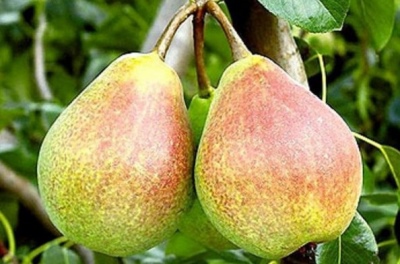
- Appeared when crossing: Alexandrovka x Klapp's favorite
- Fruit weight, g: 140
- Ripening terms: late summer
- Fruit picking time: in August - early September
- Appointment: for conservation
- Growth type: medium height
- Yield: high
- Crown: pyramidal
- Fruit shape: pear-shaped
- Fruit color: main color green, no integumentary or brick-red slight blush
Dukhmyanaya pear is a high-yielding culture. The tree is of medium height and has excellent characteristics: it bears fruit in fragrant, large, juicy, green pears with a blush. Gardeners are pleased with its abundant fruiting, resistance to freezing and diseases.
Breeding history
The variety was bred by Belarusian breeders by crossing varieties with the best fruit qualities. Officially approved for use in 1999.
Description of the variety
Dukhmyanaya pear belongs to the late summer. Feels great in protected areas. The tree itself is low, with a pyramidal crown, moderate foliage. Begins to bear fruit in late August or early September. The pears are medium in size, sweet, with a delicate white flesh. Stably begins to produce crops from the 4th year.
Fruit characteristics
Turned to the sun, green fruits, at the stage of ripening, acquire a brick-red slight blush. Pears weighing up to 140 grams are pear-shaped and have a glossy skin.
When not overripe, the pear is stored until late autumn. Ideal for use raw, in confectionery, canning, jams, jams, candied fruits, and various exquisite sauces.
Taste qualities
The pear is endowed with a pleasant, balanced sweet and sour taste. Contains 12.26% dry matter, 0.13% titratable acidity, 9.18% sugars, 13.0 mg / 100 g of ascorbic acid, tender, oily, juicy white pulp. Pleasant enough, without astringency, sweet. The fruit has a gustatory quality rating of 4.5.
Fresh consumption, without heat treatment, retains all useful elements, vitamin C, fructose, folic acid, so necessary for our body, and a wonderful aroma.
Ripening and fruiting
The Dukhmyanaya variety will delight you with delicious pears from August. Fruits ripen almost simultaneously. Branches can fall under their weight. The pear is distinguished by its unpretentious care, resistance to leaf damage, and vitality.

Yield
Pear Duhmyanaya high-yielding. During the season, the harvest is steadily up to 20 tons per hectare.
Growing regions
The variety is adapted to the soil and climatic conditions in the regions of the middle lane. The ripening time of the crop largely depends on the weather.
Self-fertility and the need for pollinators
To obtain a plentiful ovary, pollinators are needed, since Dukhmyanaya is self-fertile. The yield depends on the neighborhood of pear trees with the same flowering periods, respectively, and fruiting.
Landing
Pears of this variety are medium-sized. 1-year-old or 2-year-old seedlings are planted on a seed stock according to a 4 x 6 m scheme, in sheltered from the wind, sunny, open areas with drained-acid loose soils and some clay.


Growing and care
The fruit tree begins to bear fruit from the age of 4. Since this period, attention has been paid to feeding with organic, potash fertilizers. During the ripening period, it is good to provide moderate, restrained, but regular watering to preserve the taste and juiciness of pears. With a large harvest during the ripening period of pears, the tree needs support.
Spring preventive pruning, removal of unnecessary and unnecessary branches, crown formation, like any other fruit tree, is important for good development.



Disease and pest resistance
The peculiarity of the Duhmyanaya pear is immunity to scab, bacterial cancer. It is possible to increase the resistance to other diseases by timely feeding, pruning the crown. In the off-season, trees are sprayed with special biological and chemical agents against fungi, ticks and other parasites.

Like any other fruit trees, the pear needs protection from various diseases and pests. When planting a pear on your site, you need to know in advance what diseases you should beware of. To successfully carry out the struggle, it is necessary first to correctly identify the cause of the problem. It is important to distinguish signs of disease from manifestations of the presence of insects, mites, caterpillars and other types of pests.
Resistance to soil and climatic conditions
The variety is unpretentious, resistant to extreme external weather manifestations. It easily tolerates high temperatures, is characterized by average winter hardiness. For a guarantee, you can use additional shelter from severe frosts. According to gardeners, unfavorable natural conditions do not affect the quantity and quality of the crop.





































































